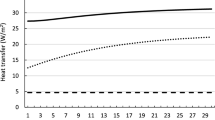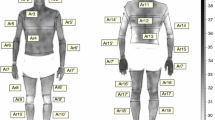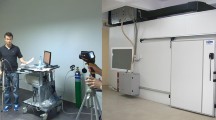Abstract
The human body regulates the body core temperature at a uniform temperature to maintain the structure and function of various physical and physiological processes. The physical exertion causes thermal stress which can disturb these mechanisms of thermoregulation under various environmental conditions and can lead to impairment of physiological functions. In view of the above, a finite element model has been developed to study thermal stress in peripheral regions of human limbs during periodic exercise and rest. It is assumed that the subject is doing exercise periodically by taking rest at regular intervals. The human limb is assumed to be of cylindrical shape. The peripheral region of a limb is divided into three natural components, namely epidermis, dermis and subdermal parts. Appropriate boundary conditions have been framed based on physical conditions of the problem. Finite element has been employed along radial and angular directions, and the finite difference is employed for time variable to obtain the solution. The numerical results have been used to obtain temperature profiles and study the effect of light-, moderate- and vigorous-intensity activities on thermal distribution in human limbs under moderate and hot climatic conditions. The results obtained by the present model are in agreement with the physiological facts and can be employed to predict the amount of acclimatization and rest required to cope up with such thermal stresses. Such models can be developed further to obtain thermal information in human organs involving physical exercise. This thermal information can be useful for developing strategies for the time period of different intensities of physical exercise and rest required for optimum performance of sportsman, labourers, workers and military person. Also the thermal information obtained from such models can be useful for developing protocols for heat stress required for therapeutic purposes during infection and physical exercise prescriptions for healthy lifestyles.
















Similar content being viewed by others
References
Agrawal M, Adlakha N, Pardasani KR (2011) Finite element model to study thermal effect of uniformly perfused tumor in dermal layers of elliptical shaped human limb. Int J Biomath 4(2):241–254
Agrawal M, Adlakha N, Pardasani KR (2015) Finite element model to study the thermal effect of tumors in dermal regions of irregular tapered shaped human limbs. Int J Therm Sci 98:287–295
Agrawal M, Adlakha N, Pardasani KR (2016) Finite element model to study temperature distribution in skin and deep tissues. J Therm Biol 62:98–105
Chao KN, Eisley JG, Yang WJ (1973) Heat and water migration in regional skins and subdermal tissues. Bio-Mech Symp ASME 2:69–72
Cooper TE, Trezek GJ (1972) A probe technique for determining the thermal conductivity of tissue. J Heat Trans ASME 94:133–140
Folk GE, Riedesel ML, Thrift DL (1998) Principles of integrative environmental physiology. Austin and Winfield publishers, Lowa
Gisolfi CV, Mora F (2000) The hot brain: survival, temperature and the human body. MIT Press, Massachusetts, pp 1–13
Gurung DB, Saxena VP, Adhikary PR (2009) FEM approach to one dimensional unsteady state temperature distribution in human dermal parts with quadratic shape functions. J Appl Math Inf 27(1–2):301–313
Kumar H, Naik PA, Pardasani KR (2018) Finite element model to study calcium distribution in T lymphocyte involving buffers and ryanodine receptors. Proc Natl Acad Sci 88(4):585–590
Khanday MA, Nazir K (2017) Mathematical and numerical analysis of cancerous tissues under the local heat therapy. Int J Biomath 10:1750099(1–10)
Kumari B, Adlakha N (2013) One dimensional finite difference model to study temperature distribution in peripheral regions of a human body during and after exercise. J Med Imaging Health Inf 3(2):179–186
Kumari B, Adlakha N (2016) Two dimensional finite element model to study thermo biomechanics in peripheral regions of human limbs due to exercise in cold climate. J Mech Med Biol 17(2):1750002(1–14)
Kumari B, Adlakha N (2017) Three dimensional finite element model to study temperature distribution in peripheral layers of human limbs immediately after physical exercise. Int J Biomath 10(4):1750053(1–16)
Lim CL, Byrne C, Lee JK (2008) Human thermoregulation and measurement of body temperature in exercise and clinical settings. Ann Acad Med Singap 37(4):347–353
Makrariya A, Adlakha N (2013) Two-dimensional finite element model of temperature distribution in dermal tissues of extended spherical organs of a human body. Int J Biomath 6(1):1–15
Makrariya A, Adlakha N (2015) Two-dimensional finite element model to study temperature distribution in peripheral regions of extended spherical human organs involving uniformly perfused tumors. Int J Biomath 8(06):1550074
Makrariya A, Adlakha N (2019) Thermographic pattern’s in women’s breast due to uniformly perfused tumors and menstrual cycle. Commun Math Biol Neurosci Article ID 14
Makrariya A, Pardasani KR (2019) Numerical study of the effect of non-uniformly perfused tumor on heat transfer in women's breast during menstrual cycle under cold environment. Netw Model Anal Health Inf Bioinform 8(1):9
Mitchell JW, Galvez TL, Hengle J, Myers GE, Siebecker KL (1970) Thermal response of human legs during cooling. J Appl Physiol 29(6):854–865
Naik PA, Pardasani KR (2018) 2D finite element analysis of calcium distribution in oocytes. Netw Model Anal Health Inf Bioinform 7:1–11
Naik PA, Pardasani KR (2019) Three-dimensional finite element model to study effect of RyR calcium channel, ER leak and SERCA pump on calcium distribution in oocyte cell. Int J Comput Methods 16(1):1–19
Pardasani KR, Adlakha N (1993) Two-dimensional steady state temperature distribution in annular tissue layers of a human or animal body. Indian J Pure Appl Math 24(11):721–728
Pardasani KR, Adlakha N (1995) Coaxial circular sector elements to study two-dimensional heat distribution problem in dermal regions of human limbs. Int J Math Comput Model 22(9):127–140
Pardasani KR, Purnima J (2000) Numerical simulation of the effect of polycythemia vera on heat flow in human dermal regions. Indian J Pure Appl Math 33(12):1595–1606
Pardasani KR, Saxena VP (1989) Exact solutions to temperature distribution problem in annular skin layers. Bull Calcutta Math Soc 81:1–8
Patterson AM (1976) Measurement of temperature profiles in human skin. S Afr J Sci 72:78–79
Perl W (1962) Heat and matter distribution in body tissues and determination of tissue blood flow by local clearance method. J Biol 2:201–235
Saxena VP, Bindra JS (1984) Steady state temperature distribution in dermal blood flow, perspiration and self controlled metabolic heat generation. Indian J Pure Appl Math 15(31–42):1984
Saxena VP, Pardasani KR (1987) Steady state radial heat flow in skin and underlying tissue layers of spherical regions of human or animal body. Int J Tech 25(4):501–505
Torii M, Yamasaki M, Sasaki T, Nakayama M (1992) Fall in skin temperature of exercising man. Br J Sports Med 26(1):29–30
Acknowledgement
This work has been carried out under the Bioinformatics Infrastructure Facility of Department of Biotechnology, New Delhi, India, at SVNIT, Surat.
Author information
Authors and Affiliations
Corresponding author
Additional information
Publisher's Note
Springer Nature remains neutral with regard to jurisdictional claims in published maps and institutional affiliations.
Rights and permissions
About this article
Cite this article
kumari, B., Adlakha, N. Two-dimensional finite element model to study the effect of periodic physical exercise on temperature distribution in peripheral regions of human limbs. Netw Model Anal Health Inform Bioinforma 9, 13 (2020). https://doi.org/10.1007/s13721-019-0217-1
Received:
Revised:
Accepted:
Published:
DOI: https://doi.org/10.1007/s13721-019-0217-1




